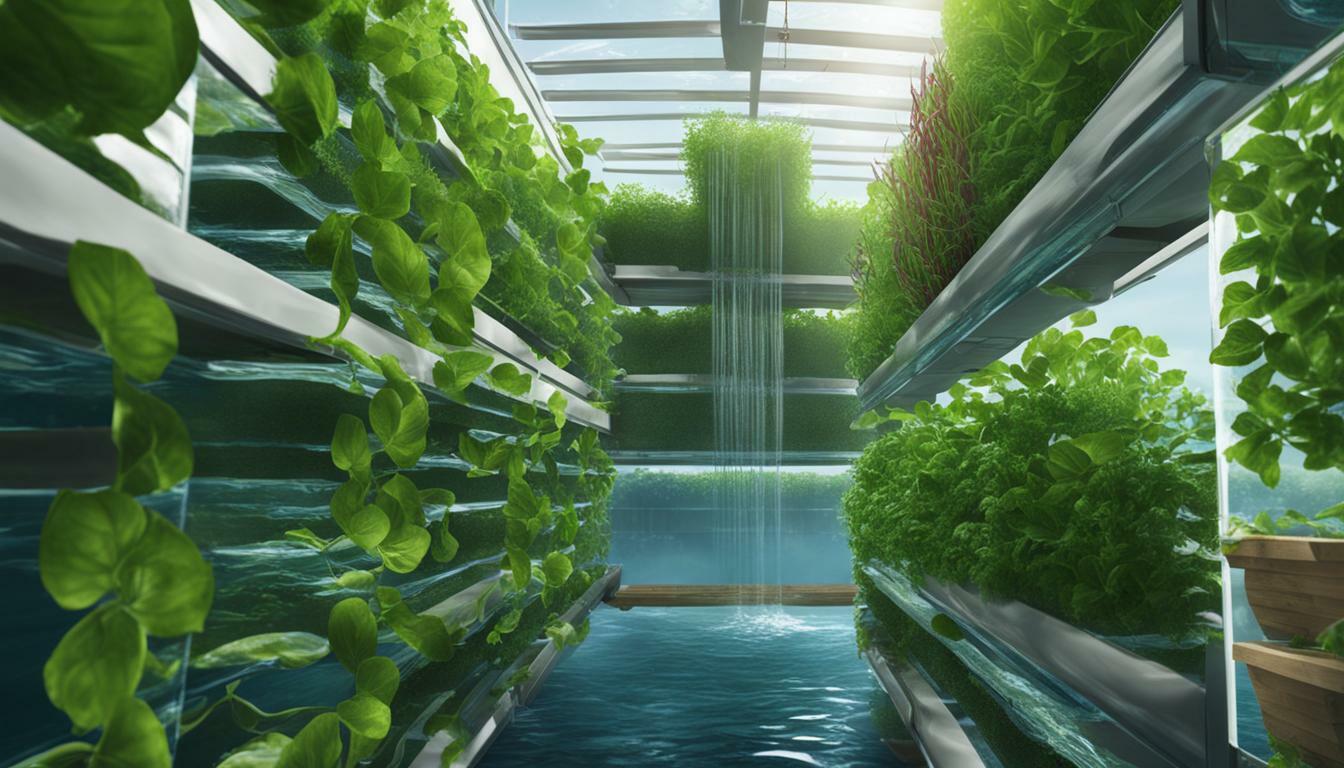Key Takeaways:
- Aquaponics is a bio-integrated system that combines aquaculture and hydroponics to grow plants using fish waste as a natural fertilizer.
- Aquaponic systems are highly efficient, producing higher yields of both fish and vegetables with less water consumption compared to traditional gardening methods.
- A vertical aquaponics system allows for maximum use of vertical space, making it ideal for those with limited garden space.
- Popular plants to grow in a vertical aquaponics system include leafy greens, herbs, and certain fruits like strawberries and tomatoes.
- Maintaining a vertical aquaponics system requires regular care such as feeding the fish, monitoring water quality, and harvesting produce.
How Does Aquaponics Work?
In this section, we will delve into the workings of aquaponics and explore the fascinating process of how fish waste can be used to nourish plants and create a self-sustaining ecosystem. Aquaponics is a bio-integrated system that combines aquaculture and hydroponics, bringing together the benefits of fish farming and plant cultivation.
The key to aquaponics lies in the symbiotic relationship between fish, plants, and beneficial bacteria. Fish are raised in a tank, and their waste produces ammonia, which can be toxic to fish if allowed to build up. However, in an aquaponic system, this waste is channeled to the plant beds, where bacteria convert the ammonia into nitrates, a form of nitrogen that plants can readily absorb and use for growth.
The plants, in turn, act as a natural filter, removing excess nutrients from the water and returning it back to the fish tank, creating a closed-loop system. The plants thrive on the nutrients provided by the fish waste, while the fish benefit from the purified water. This mutual exchange is what makes aquaponics such an efficient and sustainable method of food production.
The Aquaponic Nitrogen Cycle
The nitrogen cycle is a crucial process in aquaponics, facilitated by beneficial nitrifying bacteria. These bacteria convert toxic ammonia into nitrites and then into nitrates, which serve as a valuable source of nutrients for the plants. Without these bacteria, the ammonia would accumulate, harming the fish, and the plants would lack the necessary nutrients for growth.
| Ammonia | Nitrites | Nitrates |
|---|---|---|
| Bacteria Converts | Bacteria Converts | Plants Use for Growth |
History of Aquaponics
Aquaponics is not a new concept; it has been practiced for centuries in different forms. The ancient Aztecs were known to cultivate crops on floating islands, using the nutrient-rich water from fish farming. Similarly, in Asia, the practice of growing rice in paddy fields with fish dates back thousands of years.
Modern aquaponics has evolved through the years, with notable developments in the 20th century. In the late ’60s, pioneers like John Todd and William McLarney founded the New Alchemy Institute, which aimed to create a self-sufficient shelter powered by aquaponics. Since then, researchers and enthusiasts have continued to refine and expand the practice, making it more accessible and efficient.
By understanding the inner workings of aquaponics and its historical evolution, we can appreciate the science and ingenuity behind this sustainable food production method. In the next sections, we will explore the advantages of aquaponics, the different types of systems, and how to set up and maintain your own aquaponic vertical garden.
Advantages of Aquaponics
Aquaponics offers numerous advantages over traditional gardening methods, including increased water use efficiency, self-sustainability, and the ability to contribute to local and global food security. By utilizing a closed-loop system that combines aquaculture and hydroponics, aquaponics maximizes resource utilization and minimizes environmental impact.
Water Use Efficiency
One of the key benefits of aquaponics is its water use efficiency. Traditional gardening methods often require large amounts of water to irrigate plants, leading to water wastage and increased costs. In contrast, aquaponics recirculates water between the fish tank and the plant beds, minimizing water loss and creating a sustainable system that uses up to 90% less water than traditional agriculture.
Self-Sustainability
Aquaponics allows for the production of both plants and fish in a closed-loop system, creating a self-sustaining ecosystem. The fish waste provides essential nutrients for the plants, while the plants filter the water and create a healthy environment for the fish. This symbiotic relationship eliminates the need for synthetic fertilizers and chemical inputs, making aquaponics a more sustainable and natural method of cultivation.
Food Security
With the global population steadily increasing, ensuring food security has become a critical challenge. Aquaponics offers a solution by providing a year-round supply of fresh, nutrient-rich produce and fish. By growing food locally, aquaponics reduces the dependence on long-distance transportation and minimizes the risk of disruptions in the food supply chain. Additionally, aquaponics can be practiced in urban areas, allowing for fresh food production in otherwise limited spaces.
Environmental Benefits
Aquaponics has numerous environmental benefits, making it a sustainable alternative to traditional agriculture. By using less water and eliminating the need for synthetic fertilizers, aquaponics reduces water pollution and the carbon footprint associated with conventional farming practices. It also minimizes soil erosion and conserves land, as plants are grown without the need for soil. Furthermore, aquaponics can help restore degraded ecosystems by providing habitat for beneficial microorganisms and supporting biodiversity.
Diversifying Market Offerings
In addition to the environmental benefits, aquaponics allows for the cultivation of a wide variety of crops, including leafy greens, herbs, fruits, and even ornamental plants. This diversification of market offerings can be advantageous for farmers, as it allows them to tap into multiple revenue streams and cater to different customer preferences. By offering fresh, locally grown produce, aquaponics farmers can differentiate themselves in the market and potentially command higher prices.
Disadvantages of Aquaponics
While aquaponics offers numerous advantages, it is important to consider the potential drawbacks. One of the main challenges is the technological dependence of the system, as it relies on electricity and artificial atmosphere control. If there is a power outage or system failure, it can result in the loss of both fish and crops. Additionally, the initial setup costs can be higher compared to traditional gardening methods, although the long-term savings in water and fertilizer costs can offset this. Proper system maintenance and monitoring are also essential to prevent issues such as algae growth and water quality problems.
| Advantages | Disadvantages |
|---|---|
| Increased water use efficiency | Technological dependence |
| Self-sustainability | Higher initial setup costs |
| Contributes to food security | Maintenance and monitoring requirements |
| Environmental benefits | |
| Diversifying market offerings |
Overall, aquaponics offers a sustainable and innovative approach to food production. By harnessing the power of symbiotic relationships between fish, plants, and microorganisms, aquaponics provides a solution for growing fresh, nutritious food while minimizing resource consumption and environmental impact.
Types of Aquaponic Systems
There are several types of aquaponic systems that can be utilized to create a vertical garden. In this section, we will discuss the most common types and their unique characteristics.
Media-Based Systems
Media-based systems are one of the most popular types of aquaponic systems. In this system, plants are grown in a medium such as gravel, clay balls, or coconut coir. The medium provides support for the plants and acts as a biofilter, hosting beneficial bacteria that convert fish waste into nutrients for the plants. Water from the fish tank is pumped into the grow bed, where it filters through the medium, and the plants absorb the nutrients. The filtered water then returns to the fish tank, completing the cycle.
One advantage of media-based systems is that they are versatile and can support a wide variety of plants. Additionally, the medium provides a stable environment for the root systems of plants, allowing them to grow strong and healthy. However, media-based systems require regular monitoring and maintenance to ensure proper filtration and prevent clogging.
Nutrient Film Technique (NFT) Systems
NFT systems are another popular choice for vertical aquaponics. In this system, plants are grown in narrow channels or pipes with a thin film of nutrient-rich water flowing over their roots. The water is continuously circulated through the system, providing the plants with a constant supply of nutrients. The excess water is collected and returned to the fish tank. NFT systems are highly efficient in water and nutrient use and are ideal for growing fast-growing, leafy greens.
NFT systems require careful monitoring and adjustment to ensure that the water flow is evenly distributed and that the plants receive the necessary nutrients. Proper maintenance of the system’s water pump and filtration system is crucial to prevent clogging and ensure optimal plant growth.
Deep Water Culture (DWC) Systems
DWC systems involve suspending the plant roots in nutrient-rich water. In this system, the plants are placed in floating rafts or net pots, with their roots submerged in the water. The water is continuously aerated to provide oxygen to the plants’ root systems. As the water circulates, it passes through a biofilter to remove any excess nutrients and waste before returning to the fish tank.
DWC systems are known for their simplicity and efficiency in nutrient delivery. They are particularly suitable for growing large plants such as tomatoes and cucumbers. However, proper balancing of the system’s water chemistry and regular monitoring of oxygen levels are essential for the health of the plants and fish.
Table: Comparison of Aquaponic System Types
| System Type | Advantages | Disadvantages |
|---|---|---|
| Media-Based Systems | Supports a wide range of plants, stable root environment | Requires regular maintenance |
| NFT Systems | Efficient in water and nutrient use, ideal for leafy greens | Requires careful monitoring and adjustment |
| DWC Systems | Simple and efficient nutrient delivery, suitable for large plants | Requires proper water chemistry balancing and oxygen monitoring |
Each type of aquaponic system has its own advantages and considerations. The choice of system depends on factors such as the available space, desired crops, and level of maintenance required. By understanding the different types of aquaponic systems, you can choose the one that best suits your needs and create a successful vertical aquaponics garden.
What Makes A Right Fish?
Selecting the right fish is crucial for the success of your aquaponic vertical garden. In this section, we will explore the factors to consider when choosing fish and introduce you to some of the most popular options.
When selecting fish for your aquaponic system, there are a few key factors to consider:
- Suitability: Choose fish species that are suitable for aquaponics and can thrive in the conditions provided by your system. Some popular options for aquaponic fish include tilapia, trout, catfish, carp, largemouth bass, and even ornamental fish and invertebrates.
- Growth rate: Consider the growth rate of the fish species you choose. Faster-growing fish can provide a quicker turnover and more frequent harvests, while slower-growing fish may require more time to reach maturity.
- Diet: Different fish species have different dietary needs. Make sure to choose fish that have a diet compatible with the feed you plan to provide. Some fish, like tilapia, are omnivorous and can thrive on a varied diet of both plants and protein-based feed, while others may require a more specific diet.
- Temperature tolerance: Consider the temperature requirements of the fish species you choose. Make sure the water temperature in your aquaponic system matches the preferred temperature range for your fish. This will help ensure their health and well-being.
- Compatibility: Take into account the compatibility of different fish species if you plan to have multiple species in your system. Some fish may have specific requirements or behaviors that may not be compatible with others.
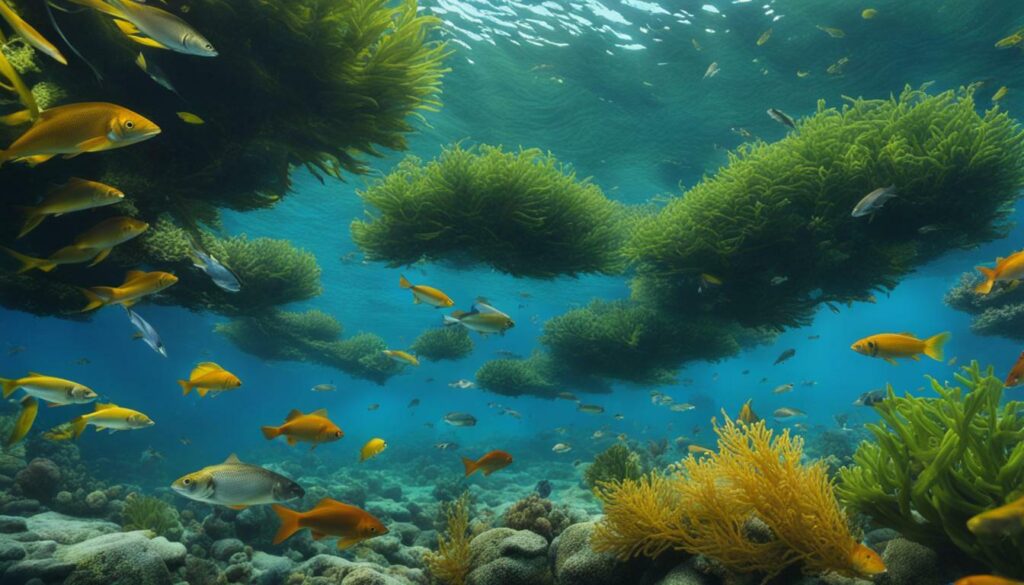
Now that you understand the factors to consider when choosing fish for your aquaponic system, let’s take a closer look at some of the most popular options:
| Fish Species | Characteristics |
|---|---|
| Tilapia | Fast-growing, adaptable, and can tolerate a wide range of water conditions. |
| Trout | Cold-water fish that require clean, well-oxygenated water. |
| Catfish | Tolerates a wide range of temperature and water quality conditions, and can be a good source of protein. |
| Carp | A hardy fish that can tolerate different water conditions and is popular in many cultures. |
| Largemouth Bass | A popular sport fish that requires a larger tank and a warmer temperature range. |
| Ornamental fish | Colorful and visually appealing fish that can add beauty to your aquaponic system. |
| Invertebrates | Species like crayfish and freshwater shrimp can be added to your system to help with waste management and provide additional diversity. |
Remember to do thorough research on the specific requirements and care needs of the fish species you choose before adding them to your aquaponic system. This will help ensure the health and success of both your fish and plants.
Nutrients in Aquaponic Vertical Gardens
Nutrients play a vital role in the growth and health of plants in an aquaponic vertical garden. In this section, we will delve into the fascinating world of nutrients and explore how they are produced through the nitrification process and utilized by plants.
How are nutrients produced during the nitrification process?
In an aquaponic system, nutrients are primarily produced through the nitrification process. This process involves the conversion of ammonia, which is excreted by fish as waste, into nitrates that can be absorbed by plants. The nitrification process is carried out by beneficial bacteria known as nitrifying bacteria, which convert ammonia first into nitrites and then into nitrates.
| Ammonia | → | Nitrites | → | Nitrates |
|---|---|---|---|---|
| Excreted by fish | Converted by nitrifying bacteria | Plant-available form of nitrogen |
Biofilter and its role in nutrient production
A key component in the nitrification process is the biofilter, which provides a suitable environment for nitrifying bacteria to thrive. The biofilter typically consists of a medium that offers a large surface area for bacterial colonization, such as gravel or expanded clay pellets. As water flows through the biofilter, nitrifying bacteria attach to the medium and convert ammonia into nitrites and then nitrates. This process ensures a constant supply of nutrients for plants in the aquaponic system.
Tips for successful biofiltration
To maintain a healthy and efficient biofilter, it is important to follow these tips:
- Ensure proper oxygenation of the biofilter by providing adequate aeration in the system. This helps in promoting the growth and activity of nitrifying bacteria.
- Regularly monitor water parameters such as ammonia, nitrite, and nitrate levels to ensure the biofilter is functioning effectively. Any fluctuations in these parameters may indicate a problem with the biofilter.
- Avoid overfeeding the fish, as excessive fish waste can overwhelm the biofilter and lead to poor nutrient conversion.
- Clean the biofilter periodically to remove any debris or accumulated solids that may hinder the bacterial activity and nutrient conversion process.
By understanding the importance of nutrients, the nitrification process, and the role of the biofilter, aquaponic vertical gardeners can ensure optimal plant growth and a thriving ecosystem within their systems. With the right balance of nutrients, fish, and plants, aquaponic vertical gardens can offer a sustainable and efficient way to grow fresh produce at home.
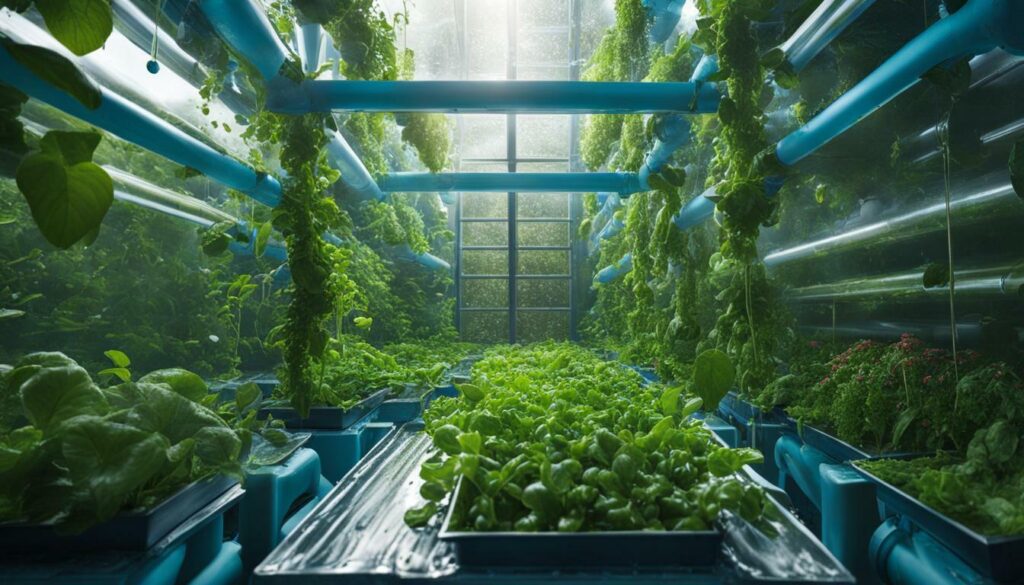
Vertical Aquaponics System
Vertical aquaponics systems offer a unique and efficient way to grow plants in a limited space. In this section, we will explore the advantages of a vertical system, how it functions, and the essential components needed for its operation.
Advantages of Vertical Aquaponics System
A vertical aquaponics system has several advantages over traditional gardening methods:
- Maximizes limited space: Vertical systems allow for the stacking of plants in vertical rows, making the most of the available space.
- Ergonomic: By keeping plants off the ground, vertical systems eliminate the need for bending over to garden, reducing strain on the back and knees.
- Easy to set up and move: Vertical tubes are lightweight and easy to set up, allowing for flexibility in positioning and relocation.
- Cost-effective: Vertical systems require minimal materials and are inexpensive to construct, making them accessible to a wider range of growers.
- Customizable: Vertical systems can be easily customized to fit different styles and layouts, allowing growers to create a system that suits their preferences.
- Great for urban farming: Vertical systems are particularly well-suited for urban environments where space is limited, allowing individuals to grow fresh produce in their own homes or on rooftops.
- Flexible growing conditions: Vertical aquaponics systems can be operated outdoors, indoors with artificial lighting, or in a greenhouse, providing flexibility in growing conditions.
How Does a Vertical Aquaponics System Work?
In a vertical aquaponics system, water is pumped from the fish tank to the top of the vertical structure and trickles down through the plant roots, providing them with the necessary nutrients. The filtered water is then returned to the fish tank, creating a continuous cycle that ensures the health and growth of both plants and fish.
Components of a Vertical Aquaponics System
A vertical aquaponics system consists of several key components:
- Fish Tank: The fish tank is where the fish are raised. It serves as the starting point for the closed-loop system, as fish waste provides a natural source of fertilizer for the plants.
- Pipes: Plants are grown in the growing pipes, which are usually set up vertically. The pipes are filled with a grow media and provide support for the plants’ roots.
- Water Pump: The water pump circulates the water throughout the system, ensuring a constant flow of nutrients to the plants.
- Aeration System: An aeration system is used to oxygenate the water in the fish tank, providing a healthy environment for the fish.
- Lighting System: A lighting system may be necessary, especially for indoor or greenhouse setups, to provide plants with the necessary light for photosynthesis.
- Plumbing System: A plumbing system connects all the components of the aquaponics system, allowing water to flow efficiently between the fish tank, grow pipes, and other parts.
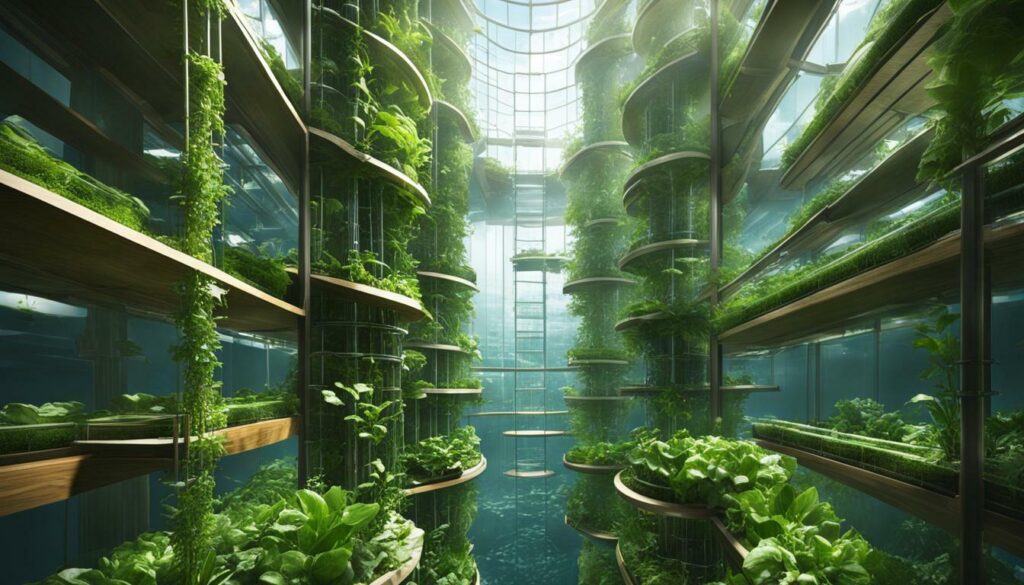
By understanding the advantages and components of a vertical aquaponics system, growers can create a sustainable and efficient system for growing their own fresh produce in a limited space. Whether you’re a beginner or an experienced gardener, a vertical aquaponics system offers a unique and rewarding way to grow plants and raise fish simultaneously.
Types of Plants Suitable for Vertical Aquaponics Systems
Not all plants thrive in a vertical aquaponics system, but there are several varieties that are particularly well-suited to this type of gardening. In this section, we will introduce you to the plants that are most compatible with a vertical aquaponics system.
Leafy greens such as lettuce, spinach, and kale are excellent choices for a vertical aquaponics system. These plants have shallow root systems and can be grown close together in vertical columns. They grow quickly and can be harvested multiple times, making them a highly productive option.
Herbs like parsley and basil are also well-suited to vertical aquaponics. They require minimal space and can be grown in small pots or hanging baskets. Plus, they add fresh and aromatic flavors to your meals.
If you’re looking to grow fruits in your vertical aquaponics system, strawberries are a great choice. They have shallow roots and can be grown in vertical towers or hanging baskets. The sweet, juicy berries are a delicious reward for your efforts.
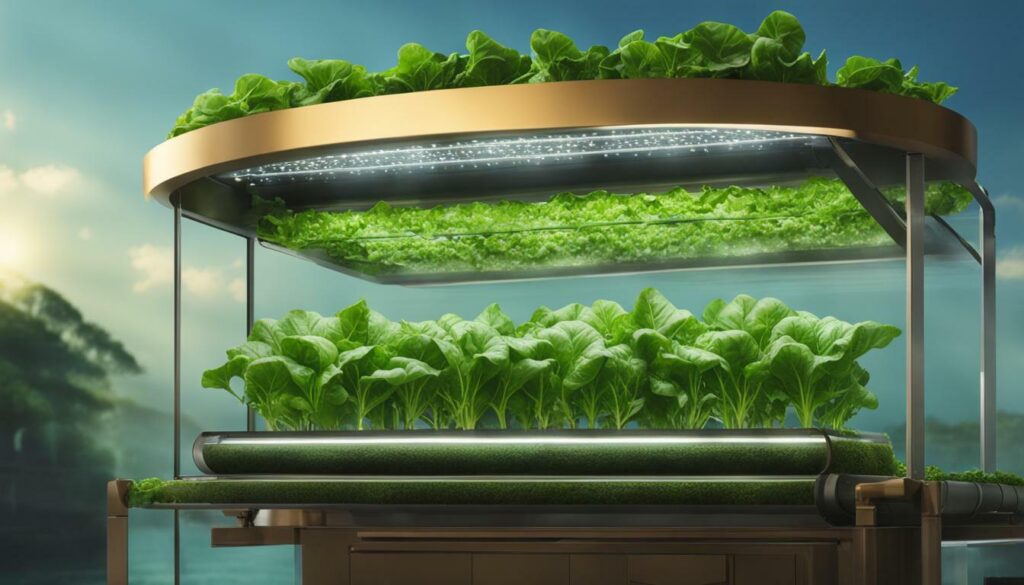
In addition to these plants, you can also experiment with other varieties like Swiss chard, bok choy, and even small vine tomatoes. The key is to choose plants with shallow root systems and compact growth habits that can thrive in a vertical environment.
Table 1: Plants Suitable for Vertical Aquaponics Systems
| Plant | Category | Root System | Growth Habit |
|---|---|---|---|
| Lettuce | Leafy Green | Shallow | Compact |
| Spinach | Leafy Green | Shallow | Compact |
| Kale | Leafy Green | Shallow | Compact |
| Parsley | Herb | Shallow | Compact |
| Basil | Herb | Shallow | Compact |
| Strawberries | Fruit | Shallow | Compact |
Keep in mind that the success of your vertical aquaponics system will also depend on other factors like lighting, water pH levels, and nutrient availability. Be sure to monitor these parameters and make any necessary adjustments to ensure optimal plant growth.
Remember, experimentation is key. Feel free to try different crops in your vertical aquaponics system and see which ones thrive in your specific setup. Happy gardening!
Setting Up a Vertical Aquaponics System
Ready to get started with your own vertical aquaponics system? In this section, we will guide you through the process of setting up your system, from choosing the right location to assembling the necessary components.
Location is an important consideration when setting up a vertical aquaponics system. Ideally, you want a spot that receives ample sunlight throughout the day, as most plants require at least six hours of direct sunlight. Consider the size and weight of your system, as well as access to water and electricity.
Once you have chosen a location, it’s time to gather the necessary components. These include a fish tank, growing pipes, a water pump, an aeration system, a lighting system, and a plumbing system. Depending on your budget and preferences, you can either purchase a pre-made vertical aquaponics setup or build one from scratch.
When assembling your system, it’s important to follow the instructions provided with your chosen setup or refer to a reliable DIY guide. Make sure to properly connect all the components and test the system to ensure everything is working correctly before adding fish and plants.
Tips for Successful Setup
Here are a few tips to keep in mind when setting up your vertical aquaponics system:
- Start with a small-scale system to gain experience before scaling up.
- Choose hardy fish species that are suitable for aquaponics, such as tilapia or catfish.
- Use high-quality grow media for your plants, such as expanded clay pellets or coconut coir.
- Monitor water quality regularly and make necessary adjustments to maintain optimal conditions for fish and plants.
- Consider adding beneficial bacteria to jumpstart the nitrogen cycle in your system.
A Sample Component List
Here is a sample list of components you may need for your vertical aquaponics system:
| Component | Quantity |
|---|---|
| Fish Tank | 1 |
| Growing Pipes | 4 |
| Water Pump | 1 |
| Aeration System | 1 |
| Lighting System | 1 |
| Plumbing System | 1 |
Remember, this is just a sample list, and you may need to adjust it based on the size and specifications of your system.
Once you have set up your vertical aquaponics system, you’re ready to start adding fish and plants. In the next section, we will discuss the process of harvesting produce from your system and provide tips for maximizing yields and maintaining plant health.
Harvesting From a Vertical Aquaponics System
The ultimate reward of a vertical aquaponics system is the ability to harvest fresh, organic produce right in your own home. In this section, we will explore the best practices for harvesting your crops and enjoying the fruits of your labor.
“The ideal plants to grow in vertical aquaponics systems are lighter-feeding plants with a shallow root system that grow quickly, such as lettuce, spinach, kale, parsley, basil, and strawberries. These plants are easy to harvest and provide a bountiful crop.”
When it comes to harvesting leafy greens, it’s best to wait until the leaves are fully matured and have reached their desired size. Simply cut the outer leaves near the base of the plant, leaving the inner leaves intact for continued growth. This will allow the plant to continue producing new leaves for future harvests.
For fruits like strawberries and tomatoes, it’s important to wait until they are fully ripe before harvesting. This will ensure that you get the best flavor and texture from your produce. Gently twist or cut the fruit from the plant, taking care not to damage the stem or surrounding foliage.
Regularly monitoring your plants for pests and diseases is also crucial for successful harvesting. Inspect your plants regularly for any signs of infestation or damage, and take appropriate action to control pests. This may include using organic pest control methods or removing and disposing of affected plants to prevent the spread of disease.
| Plant | Harvesting Tips |
|---|---|
| Lettuce | Harvest outer leaves and allow inner leaves to continue growing. |
| Spinach | Harvest entire plant or individual leaves as needed. |
| Kale | Harvest outer leaves and allow inner leaves to continue growing. |
| Parsley | Harvest individual stems or snip leaves as needed. |
| Basil | Harvest individual leaves or cut entire stems near the base. |
| Strawberries | Harvest when fully ripe and gently twist or cut from the plant. |
| Tomatoes | Harvest when fully ripe and gently twist or cut from the plant. |
Remember to always wash your harvested produce thoroughly before consuming to remove any dirt or contaminants. Enjoy the fresh, nutritious bounty from your vertical aquaponics system and share the joy of homegrown food with your family and friends!
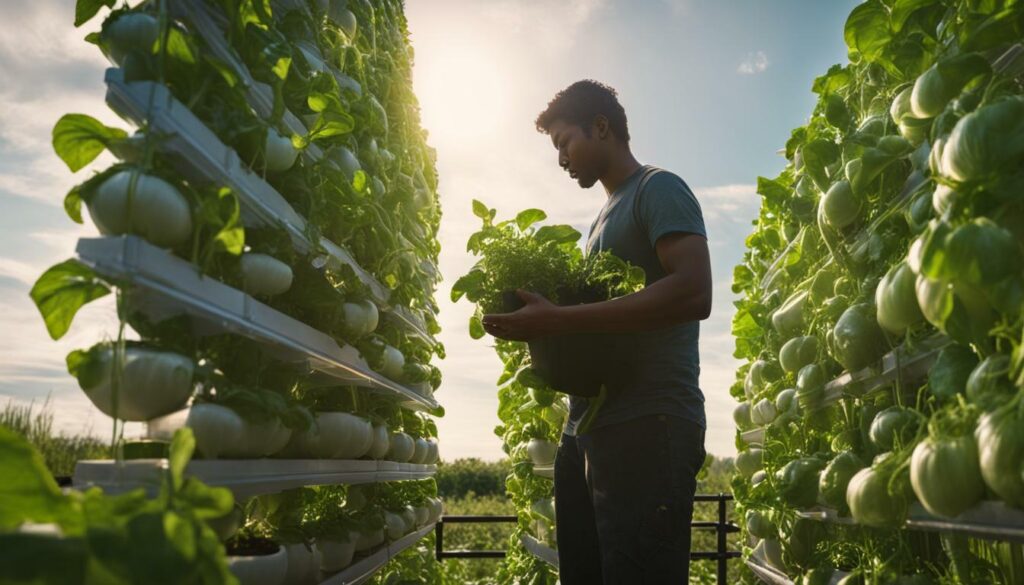
By following these best practices for harvesting and maintaining your vertical aquaponics system, you can enjoy a bountiful harvest of fresh, organic produce all year round. Happy harvesting!
Maintenance of a Vertical Aquaponics System
Proper maintenance is essential to the long-term success of your vertical aquaponics system. In this section, we will outline the daily and monthly tasks required to keep your system running smoothly and address common issues that may arise.
Daily Routines
- Check water levels in the fish tank and top up if necessary.
- Monitor the pH levels of the water and adjust as needed.
- Feed the fish with the appropriate amount of fish feed.
- Inspect the plants for any signs of pests or diseases.
- Ensure that the water pump and aeration system are functioning properly.
Monthly Routines
- Clean the filters to remove any debris or excess waste.
- Check for leaks or damage in the plumbing system.
- Trim and prune the plants to maintain their health and shape.
- Test the water quality for ammonia, nitrite, and nitrate levels.
Troubleshooting Common Problems
Algae growth: Algae growth is a common issue in vertical aquaponics systems, especially those with high-light exposure. To reduce algae growth, you can reduce the amount of light or add shading material.
Water quality issues: High pH, ammonia, or nitrite levels can indicate water quality issues. These can be caused by overfeeding, overcrowding, poor filtration, or poor water quality. Regular testing and monitoring can help identify and address these issues.
Pest infestations: Pests such as aphids or spider mites can be a problem in a vertical aquaponics system. Regularly inspect your plants for signs of pests and take appropriate action to control them.
By following these daily and monthly maintenance routines and addressing common issues promptly, you can ensure the health and productivity of your vertical aquaponics system.
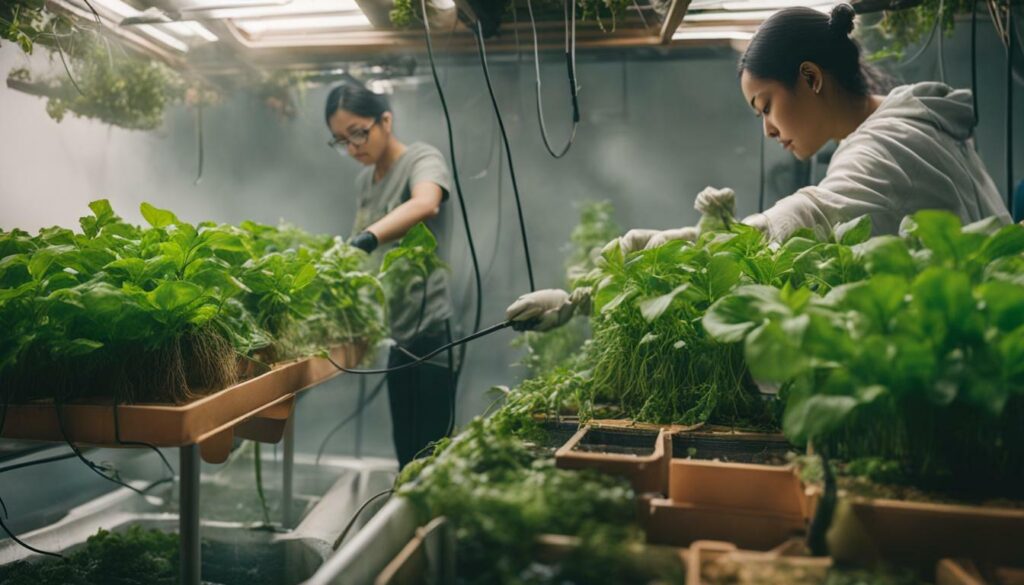
| Issue | Solution |
|---|---|
| Algae growth | Reduce light exposure or add shading material |
| Water quality issues | Regular testing and monitoring, address overfeeding, overcrowding, poor filtration, and water quality |
| Pest infestations | Regularly inspect plants, take appropriate action to control pests |
Conclusion
In conclusion, aquaponic vertical gardening offers a sustainable and efficient solution for growing fresh produce and raising fish in a limited space. By implementing the principles and techniques discussed in this guide, you can create your own thriving vertical aquaponics system and enjoy the many benefits it has to offer.
Aquaponics combines the best of aquaculture and hydroponics, creating a bio-integrated system that maximizes resource efficiency and minimizes environmental impact. The nitrogen cycle, which is at the heart of aquaponics, allows for the natural conversion of fish waste into nutrient-rich water that nourishes the plants. In return, the plants filter the water, creating a balanced ecosystem for both the fish and the plants.
One of the main advantages of aquaponics is its water use efficiency. Compared to traditional soil-based gardening, aquaponics requires 90% less water, making it a much more sustainable option, especially in water-scarce areas. Additionally, aquaponics is a closed-loop system, meaning that it recirculates water, reducing the need for water replenishment.
Aquaponics also offers self-sustainability and resilience. By creating a closed-loop system, you can produce your own food year-round, regardless of the weather conditions or external factors. This can be especially beneficial in ensuring food security and reducing dependence on external food sources.
Furthermore, aquaponics has environmental benefits. It eliminates the need for synthetic fertilizers and pesticides, reducing chemical runoff and pollution. It also promotes biodiversity, as the ecosystem created in an aquaponic system supports a variety of organisms, including beneficial bacteria, fish, and plants.
While aquaponics has numerous advantages, it’s important to consider potential disadvantages as well. Some challenges include the initial setup and investment, maintenance requirements, and the need for electricity to power pumps and other equipment. It’s crucial to do thorough research and planning before starting your own aquaponic vertical garden.
With the right fish, proper nutrient management, and a well-designed vertical aquaponic system, you can grow a wide range of plants, from leafy greens to herbs and even fruits. The vertical setup maximizes space utilization, making it ideal for urban farming or small backyard gardens.
Setting up a vertical aquaponics system requires careful consideration of factors such as location, materials, and potential challenges. By following step-by-step instructions and considering the specific needs of your plants and fish, you can create a successful and productive vertical aquaponics system.
Once your system is up and running, the process of harvesting produce from a vertical aquaponics system becomes a rewarding experience. With proper care and attention, you can maximize yields and enjoy a continuous supply of fresh, organic produce.
Maintaining a vertical aquaponics system involves daily and monthly routines to ensure the health and well-being of your fish, plants, and the system as a whole. By following recommended maintenance tasks and troubleshooting common problems, you can keep your system running smoothly and produce thriving crops.
In conclusion, aquaponic vertical gardening offers a sustainable and efficient way to grow fresh produce and raise fish in a limited space. By implementing the principles and techniques discussed in this guide, you can create your own thriving vertical aquaponics system and enjoy the numerous benefits it provides. Whether you are an urban farmer, a sustainability enthusiast, or someone looking to explore a new gardening method, aquaponics has the potential to transform the way we grow food and contribute to a more sustainable future.
Can Aquaponic Vertical Gardens be Adapted to Hydroponic Herb Gardens?
Aquaponic vertical gardens are an efficient way to grow herbs and vegetables in small spaces. By adapting them to a hydroponic system, you can revolutionize your space vertical hydroponic setup, allowing for even more flexibility in your herb garden.
Can the Plants Grown in a Vertical Hydroponic Garden Be Used in an Aquaponic Vertical Garden?
Yes, the plants grown in a vertical hydroponic garden can also be used in an aquaponic vertical garden. Both vertical hydroponic gardening options and aquaponic vertical gardens utilize the same basic principles of growing plants in a soilless environment, making it easy to transfer plants between the two systems.
FAQ
Q: What is aquaponics?
A: Aquaponics is a bio-integrated system that combines aquaculture (fish farming) and hydroponics (growing plants in a water medium). It utilizes the waste produced by fish to provide nutrients for plants, while the plants filter and clean the water for the fish.
Q: How does aquaponics work?
A: Aquaponics works by circulating water between a fish tank and a hydroponic grow bed. The fish produce waste that is broken down by beneficial bacteria into nutrients that the plants can absorb. The purified water is then returned to the fish tank. This creates a symbiotic relationship between the fish, plants, and bacteria, resulting in a self-sustaining system.
Q: What are the advantages of aquaponics?
A: Aquaponics has several advantages, including water use efficiency, self-sustainability, and environmental benefits. It allows for the production of both fish and vegetables in a small space, reduces water consumption compared to traditional farming methods, and eliminates the need for synthetic fertilizers. It also helps to diversify food offerings and improve local and global food security.
Q: What are the types of aquaponic systems?
A: There are several types of aquaponic systems, including media-based systems, nutrient film technique (NFT) systems, and deep water culture (DWC) systems. Media-based systems use a combination of clay pellets or gravel as a growth medium for the plants. NFT systems utilize a shallow stream of nutrient-rich water to grow plants in horizontal channels. DWC systems involve suspending the plants’ roots directly in the nutrient-rich water.
Q: What factors should be considered when choosing fish for an aquaponic system?
A: When choosing fish for an aquaponic system, it is important to consider factors such as water temperature, pH level, and the fish’s compatibility with the chosen plants. Common types of fish used in aquaponics include tilapia, trout, catfish, carp, largemouth bass, and ornamental fish.
Q: What plants are suitable for vertical aquaponics systems?
A: Leafy greens, herbs, and lighter-feeding plants with shallow root systems are ideal for vertical aquaponics systems. Some examples include lettuce, spinach, kale, parsley, basil, and strawberries. Fruits like tomatoes can also be grown in vertical aquaponics systems with proper care and attention.
Q: How do you set up a vertical aquaponics system?
A: To set up a vertical aquaponics system, you will need to consider the location, gather the necessary materials, and follow a step-by-step process. This includes constructing the fish tank and growing pipes, installing a water pump and aeration system, and connecting the plumbing. Ready-made setups are also available for those who prefer a hassle-free option.
Q: How do you maintain a vertical aquaponics system?
A: Maintaining a vertical aquaponics system involves daily and monthly routines. Daily tasks include feeding the fish, checking the pH levels, and ensuring the plants receive enough water. Monthly maintenance includes cleaning the filters, checking for leaks, and monitoring the health of the fish and plants. Troubleshooting common problems, such as algae growth or water quality issues, is also necessary.
Q: What are some common problems in vertical aquaponics systems?
A: Common problems in vertical aquaponics systems include algae growth, water quality issues (such as high pH or ammonia levels), and pest infestations. Taking steps to reduce light exposure or adding shading material can help control algae growth. Proper feeding, filtration, and water quality management can prevent water quality issues. Regular inspection and appropriate pest control measures are essential to prevent and address pest infestations.

